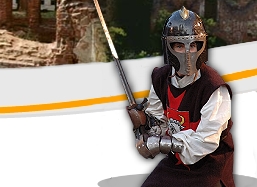|
Balga Castle in Vesyoloye (Bagrationovsk
District)
The ruins of the Teutonic castle of Balga
stand on a site formerly occupied by a dreary old Prussian
stronghold called Honeda (Choneda). Some researchers have
discovered another name of that fortress, which was 'Bolitta',
a place surrounded by marshes (swamps). The monumental timber
fortress stood on a steep hill. Its height of 26 meters gave
a chance to admire beautiful views of the Vistula Lagoon.
In the language of Baltic Prussians the word 'balga' meant
something wet and boggy. By come strange coincidence, this
word brings associations with the Russian name of the town
Bologoye.
In 1239, the Teutonic Knights seized the fortress Honeda and
raised new timber fortifications, replacing the ruined Prussian
stronghold. This was the first Teutonic fortress on the borders
of the Teutonic State and Natangia, a Prussian land. It was
from Balga that the Teutonic Knights waged their raids to
Sambia and Matangia.
In 1250, the Knights began to construct a
castle, which was to serve as a seat for the administration
of a new commandry. Přemysl Otakar II, king of Bohemia, chose
Balga Castle as a base for his expeditions to Sambia. During
some twenty years, from 1270 to 1290, the castle was completely
rebuilt. The building materials included boulders, bricks,
waterproof timber and lime.
The new monumental edifice was raised on a hexagonal plan,
with three wings. The south-west wing contained a castle chapel.
The south wing has a large refectory and the wing facing the
Vistula Lagoon comprised bedrooms. All the three buildings
were joined by roofed walkways, had deep cellars and secret
passages. The main gate was in the north-eastern part of the
castle.
East of the castle, in the outer ward, an outbuilding with
a high tower was raised. In the middle of the outer ward there
were warehouses. The south and north sections were turned
into the living quarters for Teutonic clerks. Other buildings
standing outside the main castle were barracks for mercenaries,
a mill, workshops and horse stables. Extending towards the
Vistula Lagoon, on tall pillars, stood a sanitary tower called
'dansker'.
From 1250 to 1499, Balga was the capital
seat of the commandry of Balga (Komturei Balga), which stretched
from the shores of the Vistula Lagoon to the borders with
Lithuania. In 1525, Duke Albrecht offered Balga to the Bishop
Georg von Polentz, who governed the castle until 1550. After
his death, the old fortress began to decline. In 1701, the
King of Prussia, Frederic I, ordered to use the stone and
brick from Balga Castle for construction of a new fort in
Pillau (Baltiysk).
The convent building was completely demolished, while much
of its decorations, furniture and architectural elements were
transferred to Malbork. As a result, the once undefeated fortress,
somewhat damaged by the passage of time, was now an ordinary
ruin, used like a quarry. At the end of the 19th century,
the ruined buildings of the castle, left unprotected, overgrown
with brambles and trees. In the early 20th century, Balga
received a renewed interest. The tower in the outer ward was
roofed and inside a museum was established.
In March 1945, Balga became the last post of defence for
the Hitler armies in the so-called 'Heilsberg triangle'. The
fortress yielded to the red Army after a long and fierce battle.
In the post-war times, the old castle was forgotten and became
an easy pray to treasure hunters and collectors of Gothic
bricks. This meant progressive devastation of the buildings.
Today the outer war is in a critical state and the castle
chapel is completely ruined. Although the view of the castle
walls can be depressing, the place still emanates an aura
of mystery, which attracts a great many tourists.
|






![]()
![]() On
the trail of the castles in the Baltic Sea region - revitalization and promotion
of the objects
On
the trail of the castles in the Baltic Sea region - revitalization and promotion
of the objects